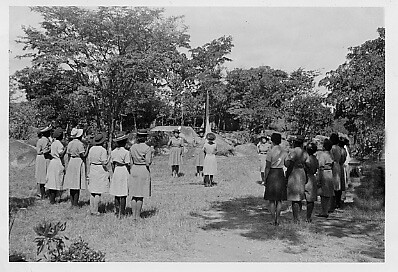Going Beyond the Barriers

Going Beyond the Barriers
Mom’s Guiding ambitions grew by leaps and bounds after that first foray at the Davies plot. She now turned her attentions to training Katie Bosman to run a Coloured Troop, and Florence Chileshe a young school teacher from Amaveni Township to run Wayfarers (a modified version of Girl Guides for Africans).
Going Beyond the Barriers
Mom, Katie and Florence set off for Ngomahuru Leper Colony and Hospital run by the Dutch Reformed Church near Fort Victoria for a Guider Training Camp to learn the ‘ropes’.
The blue uniform was color blind. Mom was in her element. It’s a long way to Fort Victoria, one hundred and eighty miles in fact, on a strip road with lots of dongas, crossing drifts and weirs. Reaching the dusty village of Umvuma, about a third of the distance was a landmark. They stopped of petrol and a celebratory Fanta for their parched throats. There would be nothing but the odd Native store from here on. They chewed up the miles as Mom taught them ‘Make New Friends’, ‘Zulu Warrior’, ‘This Land is Your Land’ and many more, interspersed with chit chat and comfortable silences in between. They munched on thick slices of bread and butter, and oranges that Florence peeled and passed the skafies (segments) around in the car. A wash down with a thermos of hot tea Mom had packed in a hamper for the way sustained them.
Finally out of the veld appeared the main gate of this huge estate set in rocky hills in broken and lovely country. Far from desolate, the flower gardens that had rightly earned the reputation of being the ‘Show place of Rhodesia,’ were a riotous welcome as they crossed the tributary of the Tokwe River with productive vegetable gardens and fruit orchards on the hillsides. Mom popped into the hospital momentarily to greet Dr. Mostert, who had sold his practice on the Giaka Mine to Dad several years ago, to follow his calling here. Ruddy faced and jovial as ever, he gave Mom a warm welcome. At the cross roads they headed west as instructed, passed Beit Hall, offices and the white washed compounds that housed the six hundred or so native lepers before they moved on down the track to the Tokwe River itself and parked at the water pump.
It was late afternoon already. Camp was well underway. The welcome scent of wood smoke, the clanking of the zinc buckets, the crunching of dry grass underfoot as the voices of the Guiders talking to each other, or singing in parts and sometimes harmonizing carried above the mournful cooing of the doves. They easily joined in. The tents were already up. They had only to roll there bedding out.
A hot stew with thick gravy in a traditional three legged iron pot bubbled over the open fire, to be ladled over a generous dollop of mashed potatoes on enamel plates. The Africans ate the stew with sadza (stiff grits, Africans’ staple food) in the traditional way. They wolfed it down in the lamplight before prayers and taps. They were asleep before lights out.
So began African and Coloured Guiding in Que Que.

